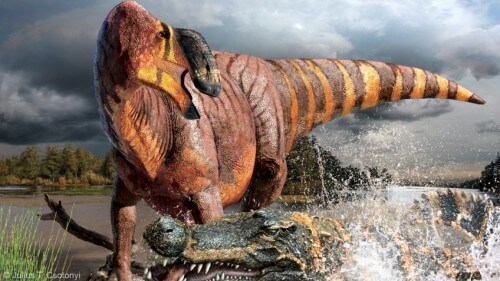Recently, a fossil of the hadrosaur was discovered in the basements of a museum, whose distinctive feature is its huge nose. The new dinosaur, named Rhinorex condrupus, lived in Utah 75 million years ago, during the late Cretaceous period.

Recently, a fossil of the hadrosaur was discovered, which is unique - its huge nose. The new dinosaur, named Rhinorex condrupus, lived in Utah 75 million years ago, during the late Cretaceous period.
Rhinorex - a nickname that can be translated as "King Kong" was a vegetarian dinosaur and close to other hadrosaurs from the Cretaceous period such as Parasaurolophus and Edmontosaurus. Drozoars are identified by the carapace made of bone coming out of their skull, except for Edmontosaurus whose carapace was made of flesh. Rhinorex also did not have a bony carapace, but instead had an enormous nose.
Terry Gates, a postdoctoral researcher at the University of North Carolina and the State Museum of Natural History, and his colleague Rodney Sheets of the Brigham Young University Museum of Paleontology rediscovered the fossil in the museum's basement. The fossil was excavated in the XNUMXs in the Neslan area of Utah, and was studied mainly thanks to the model on its well-preserved skin. When the two recovered the skull they discovered that they had a new species.
"We had an almost complete skull, but the reconstruction was difficult. It took two years to extract the fossilized bones from the sandstone it was embedded in, it's just as difficult as digging a dinosaur skull out of concrete.
Based on the bones in their possession, Gates estimated that the rhinoceros was about nine meters long and weighed about 4.3 tons. He lives in a swampy environment, about 80 kilometers from the coast. Rhinorex is the only complete hadrosaur fossil from the Neslan site, and it helps fill gaps in research on the separation of habitats in the Late Cretaceous.
"We discovered drosaurs from the same period, but from an area 300 kilometers to the south that adapted to a different environment," says Gates. "The discovery provides us with a geographical glimpse of the Cretaceous period and helps us place species in the right place and time. Rhinorex also helps us fill in the hadrosaur family tree."
When asked how the rhinoceros gained the advantage due to its large nose, Gates said, "The purpose of such a large nose is still a mystery. If this dinosaur is anything like its relatives, it may not have had an extraordinary sense of smell, and the nose was used to attract mates, to identify mates or even as an additional organ to help crush plants. We are still looking for the answer to these questions."

4 תגובות
Yeah
not exactly. Rhino is a nose in Latin. Rhinorex - "King of Noses".
In English - it is really an abbreviation of the word for rhinoceros. The translation of the full name-Rhinoceros from Latin to Hebrew is horn-nose, therefore rhinoceros 🙂
The translation of Rhino is a rhinoceros..
A Jewish dinosaur 🙂
How do you know who lives 80 kilometers from the coast?